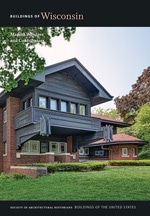
Pioneer Village is a collection of Wisconsin’s historic buildings that have been moved from their original sites and brought together in a romanticized village setting. The concept of the outdoor museum as a nostalgic representation of village life has its roots in Sweden’s Nordiska Museet, an outdoor museum of rural culture that was developed in the 1890s. Henry Ford imported the concept to the United States at Greenfield Village in Dearborn, Michigan, where in the late 1920s he assembled a collection of buildings, creating a museum of America’s past. In this same spirit, the Ozaukee County Historical Society created Pioneer Village. In 1961, the organization rescued the Michael Ahner House, a one-and-a-half-story log house built by a German immigrant in 1850. Pioneer Village now encompasses twenty-four structures, most dating to the 1840s and 1850s. Many are rare examples of their styles, most built by German immigrants. The Draeger House (1847) from Dodge County uses fachwerk construction. The one-and-a-half story house has two pairs of six-over-six double-hung windows flanking an off-center entrance. A less imposing fachwerk structure is the Karl Zettler Cottage (1849). Pioneer Village also includes blacksmith and carpenter shops, barns, smokehouses, and the former homes of Irish and Luxemburger immigrants.

